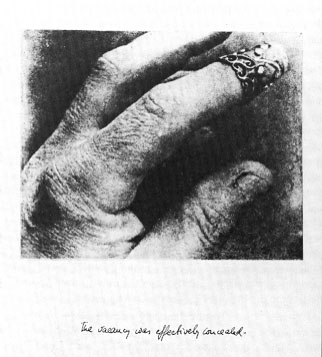Tuesday Night 03.25.03 -- Art & Ethics: A Discussion
with Luis Camnitzer
Contents:
1. About this Tuesday
2. About Luis Camnitzer
3. Links to Projects/Texts
4. "Manifesto" (1982)
5. Text for Discussion ("Form and Content") PDF

From the Uruguayan Torture, 1983
__________________________________________________
1. About this Tuesday
when: Tuesday at 7:00 pm
where: 16 beaver street, 5th floor
who: all are welcome
16 Beaver Group Art and Ethics: A Discussion with Luis Camnitzer As springboard for this conversation is a recent text by artist Luis Camnitzer, "The Form and the Content," which he recently presented in a panel discussion centering on art and ethics (ARCO, Madrid; February 2003).
In this text, Camnitzer focuses on a public address made by President Bush while playing golf, where he remarked on his indignation in view of the deaths caused by Palestinian suicide-bombers. Camnitzer analyzes this instance as if it were an artwork, dissects its form and content, makes that itself a quandary, and puts it back together to finally discuss art and ethics.
__________________________________________________
2. About Luis Camnitzer
Luis Camnitzer was born in Germany in 1937 and immigrated to Uruguay in 1939. He has been living in the United States since 1964. He graduated in sculpture from the School of Fine Arts, University of Uruguay where he also studied architecture. He also studied sculpture and printmaking at the Academy of Munich in Germany.
Links:
"Luis Camnitzer: Retrospective Exhibition, 1966-1990"
Curated by Jane Farver
The Lehman College Art Gallery, New York
(This link includes the texts published in the exhibition catalogue.)
http://ca80.lehman.cuny.edu/gallery/web/AG/luis_camnitzer/index.htm
"Uruguayan Torture"
The Alternative Museum, New York (1984)
http://www.alternativemuseum.org/exh_archive/Camnitzer/camnitzer.html
"Global Conceptualism: Points of Origin, 1950s -1980s"
The Queens Museum of Art (1999) Walker Art Center, Minneapolis (1999);
Miami Art Museum (2000); MIT List Visual Arts Center (2001).
http://www.queensmuse.org/exhibitions/concept.html
Artist's Abbreviated Biography
http://www.universes-in-universe.de/america/ury/camnitzer/e_bio.htm
Texts by Luis Camnitzer:
"Manifesto" (1982)
http://ca80.lehman.cuny.edu/gallery/web/AG/luis_camnitzer/manifesto.htm(text
included, below)
"Access to the Mainstream" (1987)
http://ca80.lehman.cuny.edu/gallery/web/AG/luis_camnitzer/mainstream.htm
"The Idea of the Moral Imperative in Contemporary Art"
(1989)
http://ca80.lehman.cuny.edu/gallery/web/AG/luis_camnitzer/idea.htm
"Letter from Porto Alegre. Mercosur" (1998)
http://www.universes-in-universe.de/artnexus/no27/cam1_en.htm
__________________________________________________
4. "Manifesto" (1982)
"Manifesto" (1982)
by Luis Camnitzer
I presume to be a revolutionary artist, with a vision for
the world and with the mission of implementing it: to eradicate the exploitation
of man by man, to implement the equitable distribution of goods and tasks,
to achieve a free, just and classless society.
In order for my mission to succeed, I have to try to communicate with
the highest possible percentage of the public, something only possible
with a great amount of production and a good system of distribution for
my products.
The production needed to reach the public who might be converted
to my ideas cannot be realized through a limited, craftsman approach.
I need means of production that are as efficient as possible and assistants
who can perform those tasks that do not require my creative effort, but
can be executed under my instructions.
Having limited funds to acquire equipment, I have to extend my ingenuity
to find good buys, to profit from errors by the sellers, to bargain to
my advantage; that is, to act with more intelligence than those who would
exploit me if I weren't careful.
Having limited funds to employ assistants with the salaries they deserve,
I have to try to pay as little as possible, prolong working hours for
the same money, try to achieve a maximum of productivity with a minimum
of expense. If this operation should leave some money left over, it should
be invested in more equipment or in employing more people under the same
conditions.
The biggest problem for the distribution of my work is competition. Other
artists, sharing as well as opposing my ideas, interfere with my potential
contact with the public. The public spends money on works that are not
mine, money that would be useful to improve and increase my means of production,
works that distract their attention from my revolutionary aims. I have
to be able to establish my work over those obstacles.
I cannot physically eliminate the artists competing with me, but I can try to harm their image, spread rumors, create rifts between them and their dealers, and generally, try to sabotage their distribution systems.
With some luck and some manipulation I can then add these
distribution networks to mine and ensure my preeminence in the public's
view. Thus I will increase my sales which will allow me to acquire more
and better means of production. I will be able to consider gaining access
to other audiences, an international public.
The day when my revolutionary ideals will become a reality therefore could
be near.
He has been exhibiting his work, writing and lecturing on art since the late sixties both in the United States, Europe and Latin America. Also, together with Jane Farver, he organized the traveling exhibition Global Conceptualisms. His work is in numerous private and public collections including the Museum of Modern Art, New York; the Metropolitan Museum of Art, New York; the Whitney Museum of Art, New York; Museo de Arte Moderno, Buenos Aires; Museo de Belles Arts, Caracas; Museo de Arte Contemporaneo, Sao Paulo, Brazil; the Museum of Malmo, Sweden; and Yeshiva University, New York.
__________________________________________________
5. Discussion ("Form and Content") Text
http://www.16beavergroup.org/formandcontent.pdf
__________________________________________________
16 Beaver Group
16 Beaver Street, 5th fl.
New York, NY 10004
phone: 212.480.2093
for directions/subscriptions/info visit:
http://www.16beavergroup.org
TRAINS:
4,5 Bowling Green
N,R Whitehall
1,2 Wall Street
J,M Broad Street
16 Beaver Group
16 Beaver Street
Fifth Floor
New York, NY 10004
212.480.2093
Trains:
4,5 Bowling Green
N,R Whitehall
2,3 Wall Street
J,M Broad Street
1,9 South Ferry
A,C Broadway
Directions:
16Beaver is located
in the Financial Dist.
east of Bowling Green
& Battery Park and
the National Museum
for the American Indian
16Beaver is east of
Bowling Green Park.
Between Whitehall &
Broad St . On the corner of Beaver & New Street